 |
||
|
||
| ||
External 5.1 audio USB device with a hardware DolbyDigital decoderBy Maxim Liadov
On March 5, 2002 Creative released a new external sound card named Sound Blaster Extigy. The device connects a computer only via a USB cable, that is why it will be useful for owners of notebooks or other computers who do not want or can't install sound cards into their PCs. Extigy is not a direct competitor of the Audigy; with this product Creative just tries to extend their market and find new niches. AppearanceCreative is the worldwide leader in the PC multimedia sphere. The company spends much time on design of its products, and the today's Extigy is a more elegant solution than even the Audigy Platinum eX.
 Unlike the Audigy which has a lot of different variations, the Extigy has only one modification. But you can choose a position of the central unit - horizontal or vertical.
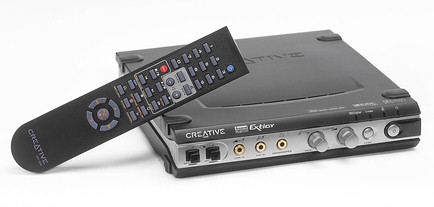 When placed horizontally, the unit stands on 4 rubber legs, while in the vertical position it stands on two plastic supports.
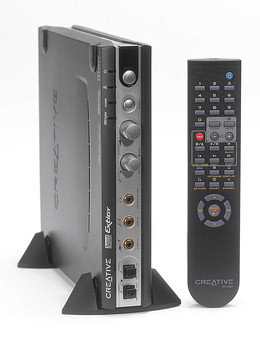 The central unit comes with a power supply unit, a wireless remote control, a USB cable to connect to a PC, a CD with drivers and programs and a brief installation manual in English. System requirementsAccording to Creative, you must have the following things to install the Extigy:
For listening to multichannel games, DVD movies and Internet radio with the Extigy it's necessary to provide:
You should realize that with the above requirements the drivers and programs will just be successfully installed and can be used. Comfortable operation of the Extigy needs a twice powerful configuration. On the one hand, a 1 GHz processor, a chipset with a fast bus and 256 MBytes of memory are not a problem today, bit on the other hand, owners of not the latest notebooks might have problems with the Extigy, namely, loss or slowing down of sound when music is played when other applications work in parallel. Everybody who likes to pester busy people with connection of Creative sound cards and setting of different operating modes should, first of all, read carefully user manuals in the PDF format. ConnectionThe Extigy has a standard set of connectors for different devices. Contrary to external units of Live!/Live!5.1/Audigy Platinum cards which were meant for professional equipment mostly, all Extigy connectors have a stereo minijack format.
 The front panel contains the most frequently used connectors, such as a linear-in and a mic-in. Each of these inputs has a separate ADC, though there is only one device for recording. The mic-in has an analog level regulator. The headphone jack has an electronic switch which turn off a signal to the speakers when the headphones are connected. The optical input and output are very handy for owners of MD player and Sony PS2 game consoles.
 Volume can be adjusted discretely with an electronic control which turns by an unlimited angle of rotation. Next to it we have a CMSS mode switch (Creative Multi Speaker Surround).
 On the rear panel there are outputs for active acoustic systems, 3 minijack analog connectors and one 4-pin minijack digital connector which is typical of Creative sound cards. There is also a digital RCA electric input and DIN-5 MIDI input and output. The IEEE1394 interface (or SB1394 by Creative) is lacking. If you need the IEEE1394 and at the same time an external unit with the maximum number of different interfaces you'd better go with Audigy Platinum or Audigy Platinum eX. Connection of the Extigy to a PCThe Extigy is developed for timid computer beginners. You have only to plug in the device, connect it to a computer with a USB cable and install drivers. Further, when you plug in the Extigy the device will activate itself and determine the number of active speakers or headphones. When you unplug the Extigy or disconnect the USB cable the previous audio device will be activated and the system will return to the initial state. Well, it will be so if you do not plug/unplug the Extigy too quickly. For our testing we used an average-level desktop system: Athlon 1200 MHz (266 bus), 512 MBytes memory at 133 MHz, a VIA KT133A chipset, and an IBM 40 GB UDMA100 HDD in the DMA mode. The system is controlled by the Windows ME (English version) and Windows XP with the installed DirectX 8.1. For the Extigy we installed the WDM drivers of 18.01.2002. There is no any drivers for Extigy on Creative's sites now, but since 04/05/2002 there is an update that renews some Extigy utilits only (including Audio Mixer and Creative PlayCenter). Anyway, when we had installed this update there were no any apparent changings. After installation of the Extigy the Windows XP puts a Safety Remove Hardware icon into the system tray which allows removing the device manually, without rebooting the system. Under the speaker there is a Creative RemoteCenter icon.
 In the Windows ME the tested sample worked worse. The sound sometimes broke when we opened and closed quite heavy applications, though the Audigy installed into the same system didn't have such problems. Windows ME is based on the old W9x core and therefore it has worse multitasking then modern WinNT core based systems (like W2K and XP). In addition, first version USB bus that used in Extigy not very suit for intensive data exchange. USB controller also has no DMA mode unlike modern PCI soundcards. According to Creative, by the time of wide popularization of the USB 2.0 the company will probably create a more perfect device realizing a new version of the standard. On the other hand, Creative is proud of the fact that the Extigy uses all capabilities of the modern USB bus, and sound processing (for example, CMSS which is a stereo virtualization for 5.1, DolbyDigital decoding) is implemented on a hardware level at the expense of the DSP. To enjoy it in full measure you'd better use the Extigy with Windows 2000 or Windows XP. Creative also said that Extigy needs a separate USB controller for normal operation. UtilitiesThe Creative Audio Mixer is a special version developed for the Extigy which reminds me of a Surround Mixer of the Audigy family.
 Click the Settings button and you will get two tabs with recording playback settings:

 Creative Play Center is the third version of the Creative's player which first appeared in the Audigy series. The utility is the most interesting for Creative's portable players. You can compress CDs into MP3 at up to 320 Kbit/s. Also, you can play AC3 files which contain a 6-channel sound track in the DolbyDigital 5.1 format.
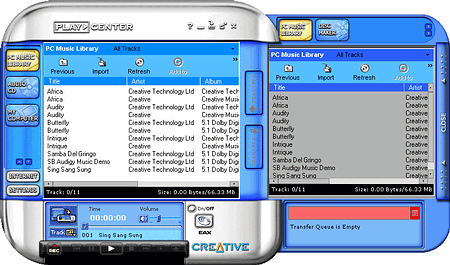 This is where you can control EAX Advanced HD Music Technologies: Audio Effects (reverberation), Time Scaling (allows the user to speed up or slow down audio or spoken word content while maintaining accurate pitch), DREAM (dynamic repositioning of enhanced audio and music), Audio Clean-Up (removes scratches, pops and hisses when recording from tapes and LPs).
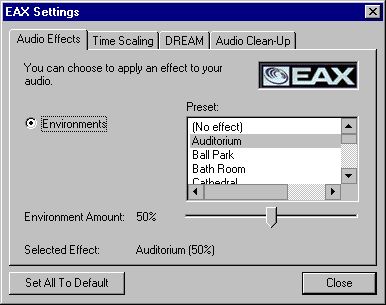

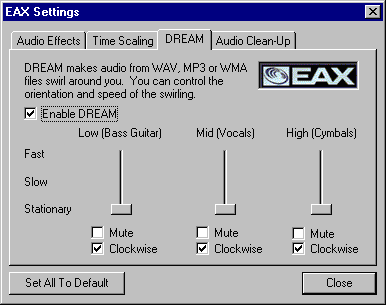
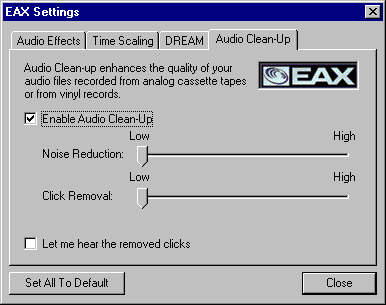 All these functions can work only when using Creative Play Center. They can't be used in a real time mode or from other applications. This plug-ins work with considerable time delay so we suppose that the effects (except reverb) have software nature like Winamp's DSP plug-ins. The latter function, Audio Clean-Up, will be useful for improving almost killed MP3 files (at a bitrate of 128 Kbit and lower). Creative Remote Center controls the Extigy with a remote control. The remote control is simple and clear, buttons are easy to press, and it's possible to navigate easily even in the dark, for example, when you watch DVD movies.
 Just insert the disc into the drive and it will take just a couple of seconds for the auto scanning to group all available media files into folders according to extensions and names. If there are ID3 tags, it's possible to group music according to performers and genres. The monitor will display big letters, and it will be easy to navigate. The digital scheme can be changed for another.
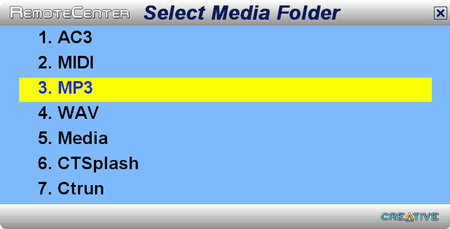 The Sound Blaster Extigy Quick Start is a high-quality professionally-designed utility which answers all questions step by step about all connectors and modes of the Extigy.
 Sound Blaster Extigy Tour is a dynamic presentation which explains all advantages of the Extigy.
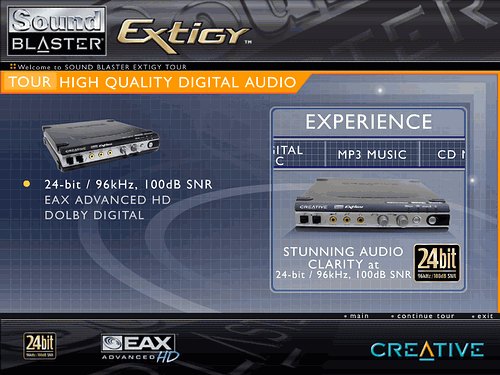 Here are some other programs which haven't changed since the SB Live! except the design:
Additional utilities on the CD
 Audio Stream Recorder is a utility that captures and records an audio stream in case of broadcasting via the Internet, for example, when you are listening to radio stations. Data are recorded into MP3 at a maximum bitrate of 128 Kbit/s. You can also structure records into playlists and then transfer files to a Creative NOMAD player connected to a computer. The utility works with any cards of the Live!/Live!5.1/Audigy/Extigy series.
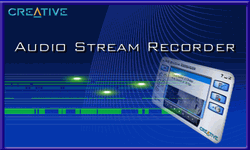
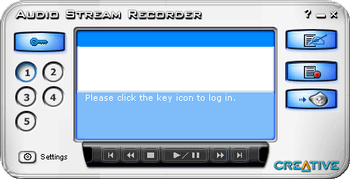 iM Radio Tuner is an excellent program for listening to Internet radio stations. It requires IE, WMP, RealPlayer.
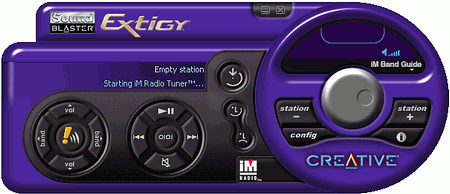 Software featuresAccording to the CoolEdit Pro diagnostics, the Extigy supports all known sound recording and reproduction formats.
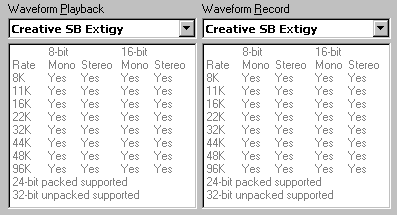 Like Live!/Live!5.1/Audigy, the Extigy supports sound reproduction from several applications. According to the DirectSound diagnostics, the Extigy has the following hardware capabilities:
Let's compare them with characteristics of the Audigy sound card.
Apart from the DirectSound3D, the Extigy supports and accelerates extensions of this API on a hardware level: EAX 1.0 and EAX 2.0. As usual, there is wrapper of the A3D 1.0 in the DS3D. We estimated quality of positioning and reverberation in the Sensaura Player3D program. The reverb is excellent. However, there are some problems, namely pops, with positioning of sound sources of the Extigy, especially in the nearest zone. By the way, when moved along the vertical plane the sound alters; it means that the Extigy and Audigy cards have normal realization of vertical positioning of sound, whatever opponents of Creative and cards with the EAX support may say. Unfortunately, the Extigy with the current drivers doesn't have preset "headphones", that is why quality of sound positioning in the headphones yields to the Audigy cards.
 New EAX extensions in games, earlier known as EAX 3.0, are now called "EAX Advanced HD Game Audio Library". It includes Multi-Environment, Environment Panning, Environment Reflections, Environment Filtering, Environment Morphing. According to the specification, the Extigy doesn't support all this stuff, and it has only EAX Advanced HD Music Technologies in 4 plug-ins for the Creative Play Center. Nevertheless, the EAX Goldmine which demonstrates capabilities of the EAX 3.0 operates flawlessly on the Extigy, and all these extensions run without problems. We think all these DS3D extensions are implemented on the program level, and the unique capability of the Audigy to support EAX Advanced HD is just a marketing step forcing owners of the Live!5.1 to turn to the Audigy. However, you shouldn't worry about it now because today there are, in fact, no well-known games supporting the EAX Advanced HD, though some hits (Soldier of Fortune 2, Hitman 2) are expected by the end of 2002. Hardware capabilities
 The Extigy uses a special chipset of the same name. A DSP installed on the card is meant for hardware processing and mixing of sound streams.
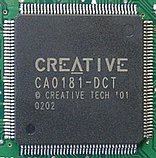 Contrary to the Live!5.1 and Audigy sound cards, which decode the DolbyDigital on a program level at the expense of drivers or a DVD player, the Extigy incorporates Hardware DolbyDigital Zoran ZR38601PQC decoder. In all other respects, the filling of the Extigy is identical to the Audigy. Besides, here we have the 6-channel 24 bit/96kHz DAC Philips UDA1328T:
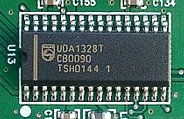 This is a 1-bit converter with oversampling and filtering. That is why its characteristics in the 96kHz mode yield to the 48kHz one. Philips UDA1328T DAC parameters (channels 1 and 2)
Philips UDA1328T DAC parameters (channel 3 to 6)
Also note that 106 dB A and 103 dB A is A-weighted noise power with no signal. Creative in its Extigy FAQ gives a wrong definition of SNR: "less noise at any given signal level". With signal this parameter falls to -95 dB for the front channel and -90 dB for others (THD+N). Of course, it's better than AC'97 codecs, where it was 96 dB A for SNR and -85 dB for THD+N. However, behind the codecs are buffer operational amplifiers which adjust a signal with a load and protects the codec from overload, and different discrete elements, including feed-through electrolytic capacitors. Besides, there are some digital distortions in a signal from algorithms of mixing and sampling rate conversion (SRC). That is why a signal coming from computer sound devices can be considered high-quality in regard to Hi-Fi and Hi-End equipment. Apart from our own measurements, which will be touched upon later, we have the Creative Confidential Sound Blaster Audigy Audio Performance Data measured on the high-quality Audio Precision System Two (approx. $28,000). The DAC (Philips UDA1328T) and operational amplifiers (ST MC33078) of the Audigy and Extigy coincide, that is why we can apply the results to the Extigy card.
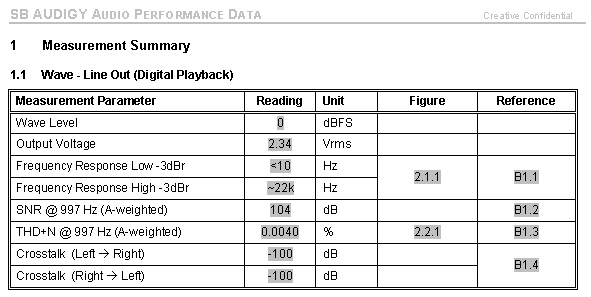 Do not be carried away by the results. First of all, it was the Reference Sample. Secondly, they measured only favorable parameters and only in one mode - 16bit/48kHz. And where is 24bit/96kHz? So, what about a low noise at any signal level? THD+N is given percentage-wise. The conversion formula (20 log ( 0.0040% /100%) gives -88.0 dB. It is interesting that now, when Creative made a transition to I2S codecs, the company explains that the most of other sound cards and mainboards equipped with AC'97 codecs do not allow for high-quality sound. The most ridiculous thing is that there is one AC'97 codec on the Audigy card. Some once brilliant Live!5.1 cards also belong to this list :) However, Creative hasn't made a quality jump yet, just an evolutionary one. On the other hand, the difference between computer sound cards (including the Extigy) and professional ones and Hi-Fi CD/DVD players will be noticeable only on expensive equipment, i.e. high-quality wooden speakers and consumer audio amplifiers. All those Creative products marked with "100 dB SNR" and "24 bit 96 kHz" suit for computer acoustic systems, including even the most expensive Creative MegaWorks 510D computer speakers at $400. Our experiments show that 99% of listeners do not notice the difference in sounding of such speakers with usual Live!5.1 or Audigy cards and professional Hoontech DSP24 and EgoSys Waveterminal cards. The Extigy uses 2 Philips UDA1361T chips as an ADC. The specification gives quite good parameters, much better than for linear-ins of different AC'97 codecs. Stereo Philips UDA1361T ADC parameters
MeasurementsAt present we do not have the professional test stand at $28,000 for absolute results, but we have RightMark Audio Analyzer program (developed by us according to the well-known white paper "Personal Computer Audio Quality Measurements" By Dr. Steven Harris & Clif Sanchez, Cirrus Logic, Crystal Audio Division), a possibility to test in any modes and full resettability and verifiability of test results. Unfortunately, the input-to-output measurements for inexpensive sound cards and devices are unsuccessful. And first of all, because quality of a linear-in is often worse than that of a linear-out, and the input is rarely used by users. However, if a device is of poor quality, it will be noticeable in the beginning. We used the professional EgoSys WaveTerminal sound card as a signal source and receiver to obtain precise relative results and choose an optimal signal level applied to and read from the tested device. The measurements were carried out under the Windows ME. Linear-out testThe 16bit/44.1kHz mode is used for listening to CD and MP3 music and reproduction of sound in games. This is a basic mode for any sound card. For the Extigy you can set manually a frequency of audio data transfer via a USB bus, as well as a primary sampling rate (in which all other frequencies will be converted in a real time mode). Creative advertises this option as a possibility to lower load on a processor and a USB bus.
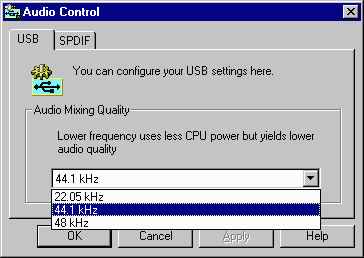 Unfortunately, 44.1 kHz is lacking in the current drivers for the linear-out. But anyway, for Creative soundcards you'd better choose 48 kHz for the digital output to avoid unnecessary resampling and problems of synchronization when a digital signal is transferred.
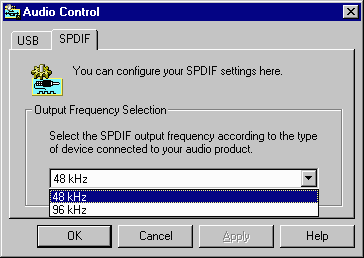 Tested chain: Extigy Line Out - WT2496 Line
In
General performance: Very good (in detail) Very good results! As compared to the Audigy, intermodulation distortions have fallen from 1.198% to 0.167%. The nonlinear ones are now 0.003% instead of 0.124%. The spectrograms prove it.
 IMD, Audigy vs. Extigy, 16bit/44.1kHz,
 THD, Audigy vs. Extigy, 16bit/44.1kHz,
But if the Audigy and Extigy have identical codecs, what happens to nonlinear distortions? The cards have different analog circuits of the front channels. The Audigy has a powerful operational amplifier to maintain the load when low-resistance headphones are connected. That is why quality of a front channel is traditionally lower than of a rear one. There are even special unnoficial KX drivers (which, unfortunately, do not support DirectSound) where the channels are interchanged by default. To check it we soldered the contacts right to the output pins of the DAC of the Audigy, to a front channel. There were, luckily, two inverted outputs of the front channel (VOUT1N - 29, VOUT2N - 31) which were not used. They allowed us to compare the sound by switching between the codec and the front output. I recommend to repeat the experiment only to users who know radio electronics quite well.
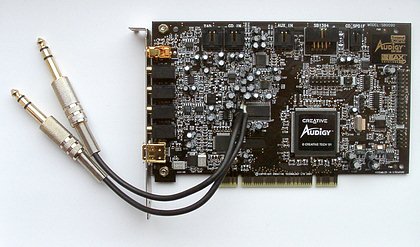
Compare the THD (nonlinear distortions, %) for the Audigy Codec Max vol and Audigy Front Max vol. The difference is amazing: 0.002% against 0.124%. Though the difference is not very audible. The signal from the codec is twice weaker in power. Note also that headphones need a powerful buffer amplifier, otherwise the output stage can be overloaded at the middle and high volume level at the low-resistance load. The problem often occurs in case of mainboards with a built-in codec where headphones work with a high distortion level. The picture also demonstrates it; it also shows that a distortion level grows proportionally to a signal level. And the SNR will be maximum at the highest signal level.
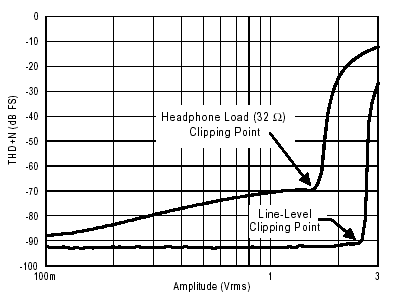 The 16bit/48kHz mode is used for watching DVD and MPEG4 movies, listening to DVD concerts with an audio track in the linear PCM format. Tested chain: Extigy Line Out - WT2496 Line
In
General performance: Very good (in detail) In this mode the Creative products are traditionally strong. Let's compare the card with the Audigy.
The Audigy's front channel shows more distortions, the signal parameters of the codec are almost identical to those of the Extigy. However, for headphones on the Live!5.1/Audigy it's possible to use a rear-out by switching the card into the "4 speakers" mode when the front and rear are duplicated. And now let's take a look at the tests in the 24bit/96kHz mode the support of which is so much emphasized by Creative. In the Audigy this mode wasn't flawless. The problem is that the EMU10K2 works at 48 kHz, and 96 kHz is reproduced with resampling. It's like a video card working in the 1280x960 mode which renders an image for 640x480 and uses interpolation for the higher resolution. Besides, DAC has worse characteristics in 96 kHz than in 48 kHz mode. Tested chain: Extigy Line Out - WT2496 Line
In
General performance: Very good (in detail) There are actually no records in this mode now, except such exotic ones as DVD Audio or musicstudio phonograms. That is why this mode is interesting mostly for musicians. And since the Extigy is not a good choise for such people, let's leave this mode aside. We just want to note that the AFC (FR) is better than in the Audigy.
 AFC, Audigy vs. Extigy, 24bit/96kHz,
Well, comparison of the Extigy and Audigy in this mode is not of much interest. For a gamer the 24/96 mode is useless, and a musician would better buy a professional sound card on the Envy24 and AKM codec. By the way, the Audigy can't record in the 24/96 mode at all. The Extigy makes some attempts, but the outcome is terrible with the current drivers.
Linear-in testThe linear-in of the Extigy has low sensitivity to some reason, that is why we had to apply a signal of a quite high level. Tested chain: WT2496 Line Out - Extigy Line
In
General performance: Good (in detail) All results are rather good except the IMD, although all measurements were made in the 44.1 kHz mode. You should realize that the measured intermodulation distortions makes sense only at high frequencies that is why it brings the most troubles for those who record music from a radio tuner when broadcasting at 19 kHz gives a pilot signal of a high level. Some advanced tuners have a filter which cuts off frequencies higher than 15 kHz. The general recommendation for all current Creative sound devices is to record only in the 16/48 mode. Tested chain: WT2496 Line Out - Extigy Line
In
General performance: Very good (in detail) In this mode the Extigy performs very well. Let's take a gander at the comparison table for the Extigy and Audigy. Both cards perform equally: the Extigy is ahead in a noise level, Audigy in distortions.
At last, we have the 24bit/96kHz mode which is currently working incorrectly. Here is what we get when we apply to the input a 1kHz sinusoid @ -3 dB.
 THD, Extigy, 24bit/96kHz, It seems that the recording is implemented in the 8bit/22kHz mode and then calculated into 24bit/96kHz. We have the same impression when we recorded in real conditions. Well, let's wait for corrections or exclusion of this mode from the working ones, like in case of the Audigy. Headphones jackThe Philips UDA1334A chip is used as a DAC for headphones. The Live!5.1 has the same converter on the real channel. The Audigy Platinum eX has a more interesting 24bit/192kHz stereo DAC Wolfson XWM8728. Tested chain: Extigy Headphones Out - WT2496
Line In
General performance: Very good (in detail) Tested chain: Extigy Headphones Out - WT2496
Line In
General performance: Very good (in detail) On the whole, the Extigy's headphones jack demonstrates decent characteristics. The respective output of the Audigy Platinum eX has similar parameters. Extigy and MIDIUnlike the Audigy, the Extigy is not meant for musicians. Samples loaded into RAM of a computer are not supported on a hardware level neither in the SoundFont format nor in any other (Creative recommends to use program synthesizers with the SoundFont support from third developers - LiveSynth for Sonar and BS-1 for Cubase). Instead of a hardware synthesizer which is typical of Creative cards there is a program one. It based on software synthesizer which provides unnecessary 1024 MIDI voices in Live!/5.1/Audigy. Fortunately, quality of the soft MIDI synthesis of the Extigy is better than it was in the previous generations. Reverberation is lacking at all, and there is only chorus which gets enabled for the whole MIDI synthesizer and which can't be adjusted for separate channels. Quality of the chorus is quite good, but it looks odd without reverberation. The ASIO is not supported, though there are such drivers from other developers and, according to Creative, they will soon get the Extigy support. Nevertheless, Creative recommends to use Audigy cards for the ASIO. I advise to use the Audigy + ASIO system only for home musicstudio and if you are short of money. For professional work you'd better get a card on the Envy24 and AKM codec. We tested the Extigy in the Sonar 1.0.1 under the WindowsME. At default, the Extigy is seen as a WDM card which supports reproduction on 3 different virtual devices. However, a record device is monophonic. Despite the optimistic diagnostics and 10ms latency it's impossible to work with audio on the Athlon 1200 processor at such latency because of lack of power. Increasing a size of the buffer didn't help much though it unloaded the processor.
 If you set in the Sonar an option of force utilization of the MME interface the Extigy will get MME compatible devices: one for recording and one for playback.

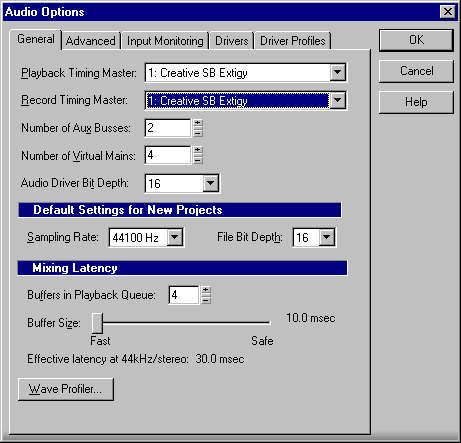 The operation becomes easier though the minimal latency grows up. The most important thing is that you can choose three recording devices: for a right channel, a left one and a stereo device. The recording works well, though there are still problems in the MIDI of unevenness of playback during recording. It's possible that the USB bus bandwidth is too narrow or the processor is too weak to transfer audio streams and for program playback of the MIDI synthesis. The main conclusion is that the Extigy is not the best choice for a musician. They should take at least Audigy card with WDM drivers. I think, the Extigy is best for playback of Karaoke and for various simple MIDI applications. In this case the CPU utilization doesn't exceed 1%. Subjective testsFor listening we used two acoustic systems.
We were mostly interested in difference in sounding of the Audigy and Extigy. Although the Extigy has better measurement results than the Audigy, both models are almost equal in sound. It is shown by the blind tests with instant reswitching between the cards and listening to them on the reference Event acoustic system. The Extigy sounds good both in speakers and in headphones. Nothing more is needed for multimedia and games because quality of original samples will be determining. Both Extigy and Audigy have decent quality for MP3 music with middle bitrates. The CMSS which gives stereo sound on all 6 speakers hasn't impressed us much. Music does come from the center and rear satellites but the stereo panorama gets worse. This mode would suit better for DTT3500 or Inspire 5700 speakers which have a more powerful central channel and where small speakers do not allow making a uniform sound environment without using of all 5 satellites. Besides, some people can consider a position of a listener queer when he is not in front of the imagined scene but on the band-master's place. The IHOO without Bass Redirection provides too few basses. The LF filter cutoff frequency for the subwoofer can't be adjusted in the Extigy, contrary to the Live!5.1 and Audigy, though it's possible to adjust balance of the channels and adjust a volume level of the subwoofer and the central channel separately. DVD moviesThe Extigy has an integrated DolbyDigital hardware decoder which can reproduce audio tracks of DVD movies in this format. For most of users a hardware decoder in the Extigy is not more than just an interesting fact as any decent program DVD player can decode into 6 channels both DolbyDigital 5.1, and DTS and others. And owners of a non-portable DVD player or a Sony PS2 game console can use the Extigy as a separate DolbyDigital decoder. The Extigy will be also a useful purchase for owners of mainboards based on the nForce 415/420D with a digital S/PDIF-out but without 6 analog channels (for example, from MSI). Nevertheless, to make the built-in decoder work you must enable "S/PDIF output only" for audio in the settings of the program DVD player. To decode a multichannel sound on a program level you must set the "6 speakers" mode. We checked both modes in the DVD players WinDVD 3.0 and PowerDVD XP 4.0. Everything worked excellently. The sound was clear and distortionless. Hardware decoding of the DolbyDigital turns on a respective lamp on the front panel of the Extigy. The hardware decoder must be using a compressor because the sound it produces is too loud and clear. The same was noticed when we tested the Creative DTT3500 and Inspire 5700 systems. GamesThe card was tested in the Serious Sam: Second Encounter and Unreal Tournament 4.36 with EAX 2.0 enabled under the WindowsME and DirectX 8.1. In the Serious Sam the sound on the Extigy was free of delays and stuttering even at 1024x768x32 which is the best mode for playing, and all the settings were highest. Probably it's because of the platform (GeForce3 Ti200, Athlon 1200, 512 MBytes memory), while there can be problems on a weaker machine. The Audigy and Extigy showed in the demo 59 and 57 fps respectively. The sound was excellent in the speakers in both cases. In headphones the Audigy looks stronger as the Extigy doesn't have a special mode for headphones in the current drivers, that is why the sound positioning is not clear. The Unreal Tournament has some bugs related with sound, and even its patched version doesn't reproduce all sounds always correctly. That is why pops and loss of sound on the Extigy working under the Windows ME can be accounted for the bad work of the Epic programmers and bad multitasking in W9x. However, artifacts can be decreased considerably if you set Low Quality of sound in the game and choose 22kHz of data transfer in the Extigy settings. The system performance will also improve. In the Windows XP no such problems occur. At the High Quality of sound and in a 44kHz mode of the USB bus images in the game are drawn smoothly and the sound brings no artifacts. ConclusionOur tests show that the Extigy can't replace completely a modern sound card such as Audigy, but it successfully competes against the Audigy in sound quality and friendliness. At the same time, the Extigy is cheaper (by $100) than the Audigy Platinum eX. On the one hand, the USB bus used for connecting the card with a computer makes possible to connect the Extigy to any computer having a respective connector. On the other hand, the first version of the USB bus standard doesn't very suit for music composing or 3D games, especially under the Windows ME. However CD, MP3 and DVD are reproduced without any problems. The remote control makes navigation simple and easy. And a heap of inputs and outputs allow connecting the Extigy to almost all existent sound devices. Besides, there is a hardware DolbyDigital decoder which can work independently. Advantages of the Sound Blaster Extigy:
Disadvantages of the Sound Blaster Extigy:
Write a comment below. No registration needed!
|
Platform · Video · Multimedia · Mobile · Other || About us & Privacy policy · Twitter · Facebook Copyright © Byrds Research & Publishing, Ltd., 1997–2011. All rights reserved. |